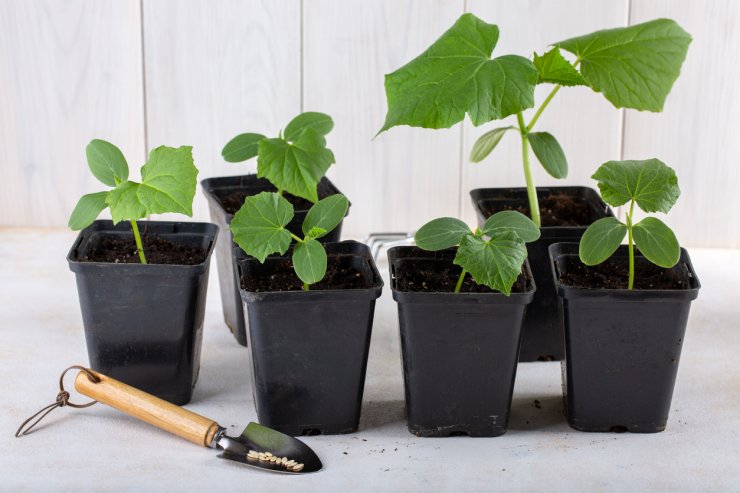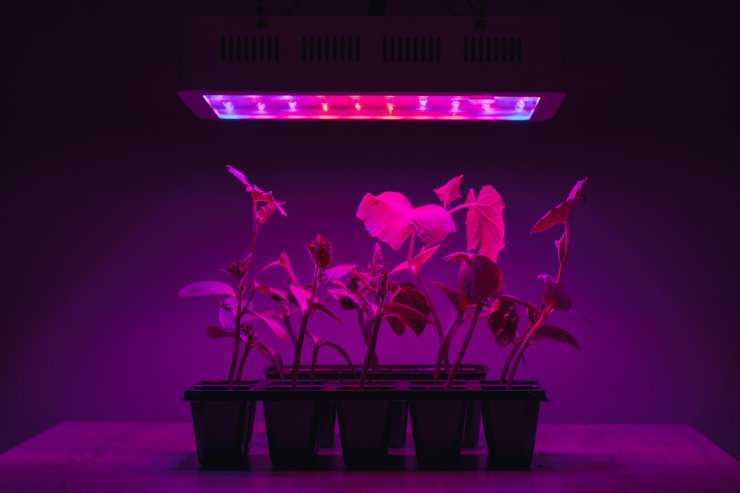
Cucumbers in pots with small spade.
You’ll get the most out of your cucumber garden—and enjoy it more—if you have the right tools for the job. And you need the right tools in the kitchen, too, for being able to prepare cucumbers for your eating enjoyment!
Below is a list of items to consider. If you don’t already have some of these items, please check our Resources section at the end of this collection for some recommended suppliers for acquiring the right tools and equipment.
Cucumber-specific tools and equipment:
Cages and Trellises
Bush cucumbers grow closer to the ground in “bush” style, often growing 2 to 4 feet tall. Cages will help cucumbers stay close to the ground without laying directly on the ground. Cages can also support cucumbers grown on pots.
Vining cucumbers need plenty of space to grow. If you have room in your garden for them to spread—up to 8 feet—you will not need support. But if you want them to take up less real estate in your patch or grow them in containers, you will need a trellis. Trellising your cucumbers can help keep them clean, provide air circulation, and can add interesting architecture to your garden. You can purchase a trellis from your garden supply store or make one yourself. Metal A-frames, teepees made from wooden dowels and string, and wood or metal frames with string all make easy and attractive trellises.
Cucumber Peeler: Unlike store-bought cucumbers that have been waxed, you really don’t need to peel washed, homegrown cucumbers. Many varieties have tender skins that are full of fiber and nutrition. However, if you prefer to remove the outer layer, a vegetable peeler is the best way to take off the skin while retaining most of the flesh. You can also use your peeler for potatoes, carrots, and most other vegetables or fruits. An essential kitchen essential, and they’re inexpensive, to boot!
Melon Baller: Cucumbers are members of the melon family, and this tool is usually used to create pretty balls of fruit from the flesh of melons. However, a melon baller also does a great job of removing the seeds from cucumbers! Slice the cucumber vertically, then drag the melon baller from one end of the cuke to the other, efficiently removing the seeds. Clever, no?
For the High-Tech Cucumber Gardener

Cucumber sprouts under a grow lamp.
Here are some items that are more than just “equipment”—they’re not needed for you to be an awesome cucumber gardener, but they can help simplify the growing process and take your garden to a whole new level!
Grow Lights
When growing cucumber plants from seeds, you can start indoors before the season beings, but, if you lack southern-facing windows to gain that light, grow lights are a great solution. Use grow lights only to get your seeds to the seedling stage, then plant them outdoors in the appropriate natural light.
Grow lights can allow you to extend the growing season, or even to grow cucumbers all year long—remember Tiberius—but use a lot of energy and require more work and attention from you.
Greenhouse
If you want a large garden of cucumbers and other vegetables and fruits, a greenhouse will allow you to start a mass number of seedlings all at once. With a greenhouse, you’ll have plenty of semi-indoor space and a more controlled environment for getting a bigger and more diverse garden launched.
A greenhouse would also allow you to think about making extra income from your garden. You can sell excess garden seedlings from your home or from a table at the local farmer’s market, or even just gift them to gardening friends and family.
Greenhouse styles include pre-fabricated or handmade—or you can design one that includes both. A greenhouse is a big investment, but can provide you with more cucumber-gardening options and allow you to expand your overall garden.
Hydroponic Irrigation System
Hydroponic gardening has been growing in popularity in recent years—who knew that you can grow cucumbers without soil! And while hydroponic gardening is a science in a lot of ways, as with all things gardening, there’s also an art to it.
Most hydroponic gardeners swear that cucumbers grown hydroponically taste just as good—the same—as soil-grown cucumbers. So, this can be a great solution for anyone who doesn’t have easy access to land and soil.
Containers and Pots
If you want to start plants indoors before the outdoor growing season commences, you can try several environmentally friendly and free ways to begin with materials you probably already have:
- Newspaper or brown-paper pots
- Egg cartons
- Toilet-paper rolls (yes, these work great!)
- Random containers, kitchen pans, or baking sheets (you might need holes drilled into the bottom for drainage)—if you have aging or rusting kitchen pans that you’re looking to replace, they make for great “starter pots” for getting your garden launched inside
- Starter trays and peat pots
Garden Gloves
Using a pair of garden gloves—and wearing long sleeves—when you’re tending to your plants is a good way to avoid skin irritation and to protect your fingers, hands, and arms. Get a comfortable pair of gloves that fit well, so you still have full dexterity in your garden.
Garden Trowel
A useful garden tool, the garden trowel is handy when filling your containers and when mixing compost and worm castings. Avoid cheap versions that can have flimsy handles that are prone to break. Even inferior metal trowels can bend in hard clay or rocky soil. Invest in a higher quality trowel, and you’ll have it for years!
Irrigation Equipment
Many plants thrive when watered slowly and deeply. While tedious and even sometimes difficult to do with a watering can, you might want to consider an irrigation method for keeping your plants slowly and deeply watered.
A standard sprinkler system is not the best solution—while easy to set up, the wide-ranging water coverage of a sprinkler can lead to wet plant leaves that promote diseases and can encourage weeds.
A drip-watering irrigation system that operates on a timer is one of the best irrigation solutions for watering plants. This type of system better controls how much water you use, minimizes water lost to evaporation, and more exactly directs water to where you want to soak your soil. While more expensive than a simple watering can, an investment in an irrigation system can pay off—specially to ensure proper watering when you’re at work or on vacation!
Pruners or Snippers
Wear your garden gloves while pruning, and be sure to get a set of pruners or snippers that are comfortable in your hand when cutting. Don’t skimp on this—you need something that cuts well and will endure through many seasons.
Rain Barrel
Some areas of the country experience drought conditions in the spring and summer, and some municipalities may impose watering bans; that means hand watering only. If you collect rainwater, you can put it to good use when it comes time to tend your plants. Some communities offer rain barrels at a special discount to encourage water conservation.
Spade
Every gardener—no matter what plants you’re tending—needs a spade, or even several of different sizes. Use your spade to move around compost, dig soil for your initial plant hole, and to keep your garden soil tidy.
Spray Pump or Bottle
To control the emergence or spread of plant diseases and pests, get a dedicated spray bottle for your potion to do the job. This is one thing you can go basic on—no need for anything fancy, as a simple plastic spray bottle is fine.
Watering Can
Watering cans allow you to better control exactly where the water is directed in your garden. Plant leaves and fruit don’t need water, the roots in the soil do. Get yourself a good-sized watering can, and have some fun finding a watering can with an interesting design that fits your personality. Also, you want one that has a comfortable grip.
Wheelbarrow
A wheelbarrow makes it easy for you to move soil and mulch from plant to plant; and it works as an excellent mixing bowl when you’re combining the perfect soil blend. If you feel like a wheelbarrow is just a little over the top for your gardening needs, a 5-gallon bucket may suffice. Just make sure you have a good trowel to mix with.
Do you have any essential gardening tools you use that aren’t listed here? Please tell us which items you absolutely need for your gardening.
Do you have any essential gardening tools you use that aren’t listed here? Please tell us which items you absolutely need for your cucumber gardening.


 Previous
Previous

